Álvaro Cogollo uses popular music to entice Colombians to love nature
| MedellÍn, Colombia; and New York
As a boy growing up on a farm near the Caribbean coast of Colombia, Álvaro Cogollo loved the forest. His grandfather taught him the common names of the plants, trees, and animals, and Mr. Cogollo would disappear for hours with a notebook, recording the explosion of life he found there.
After long days harvesting cotton and corn, Cogollo's laboratory was the forest. And vallenato, the traditional music of the region, with its upbeat accordion, distinctive rhythms, and poignant lyrics, was his soundtrack.
Plants and vallenato have been lifelong passions for Cogollo, now the scientific director of the Medellín Botanical Garden. His Spanish teacher, a folklore enthusiast, encouraged an early interest in the music.
Later, as a biology student in the 1970s, Cogollo studied plant taxonomy by thinking of all the plant references he could remember from classic vallenato songs. He has since traveled around the country to document its rich botanical heritage and, informally, studied the music that tells an important story of Colombia.
"We were colonized by the Spanish; later, Africans were brought as slaves to exploit gold mines; and the indigenous peoples were [already] here," he says. "That is what authentic vallenato represents with its three instruments: the accordion, from a European origin; la caja [drum], which is of African origin; and la guacharaca, a percussion instrument made from a palm trunk, [which] is from [indigenous] American origin."
Over the course of his nearly four-decade career, Cogollo has discovered more than 150 new species of plants, 17 of which bear his name. He has won numerous awards for his research and mentored many young biologists.
"Working with him is really incredible because he can just stop and talk about a plant, how it grows, the distribution, the ecology, the uses, the names – he's a real bible for botany in Colombia," says Saúl Ernesto Hoyos Gómez, a botanist who directs a Colombian conservation organization called Fragmento and who first worked with Cogollo as an undergraduate biology student. Mr. Hoyos Gómez still reverently calls Cogollo el profesor.
Although Cogollo never earned a PhD, his colleagues say he's made invaluable contributions to knowledge of Colombia's flora at a time when deforestation poses a grave threat to the country's biodiversity.
"My opinion is that he is probably the best field botanist there is in Colombia right now," says Enrique Forero, a member of the Colombian Academy of Sciences who has known Cogollo for 25 years.
Research and environmental protection have never been priorities for a country mired in battling armed groups and extreme income inequality. Governments have focused on trying to move the country out of poverty and conflict through exploiting its natural resources, not through sustainable resource development.
Cogollo sees things a different way. By making a thorough inventory of Colombia's flora, educating the public about alternative uses for the land, and researching plants' potential uses – including as pharmaceuticals, foods, and sustainable bio-fuels – Colombia could improve its economy and quality of life without neglecting conservation, Cogollo says.
"He's always trying to make people understand that the biodiversity can be used in a sustainable way and as income for the community," Hoyos Gómez says.
Cogollo's vision involves creating a more equitable economic system for poor, rural people who depend on forests. John Pipoly, an American botanist who began collaborating with Cogollo in the 1980s, says he always employs local people on expeditions, exchanging knowledge with them about traditional and potential new uses for indigenous plants.
"Cogollo's approach is, 'Let's figure out how to help these people be sustainable,' and asking what returns will people see on investment of working with us short- and long-term," Dr. Pipoly says.
Cogollo's other major achievement has been the transformation of a neglected botanical garden in a downtrodden Medellín neighborhood into a renowned center for research, environmental education, and community gatherings. What had been an exclusive club mainly for wealthy orchid enthusiasts now offers free admission and attracts rich and poor alike.
The success of the botanical garden has in turn contributed to the transformation of Medellín. Once paralyzed by violent turf wars between armed groups, the city has embraced civic improvements that include better public safety, tougher pollution controls, a modernized public transportation system, and the creation of green spaces.
The botanical garden is a centerpiece of efforts to "green" the city.
Today, Colombians are beginning to develop an environmental consciousness, Cogollo says. But there are huge disparities between environmental conditions among wealthy and poor communities.
And that's where he has focused his latest efforts, teaching Colombians from all social classes and backgrounds about the importance of biodiversity and conservation through a shared musical heritage.
"The fact that Álvaro's been able to give ... talks to audiences filled with all kinds of people is very important, and that's what happened in Medellín the first time [he talked about vallenato music]," Dr. Forero says. "People sitting there had no idea of the [science], and then they did."





